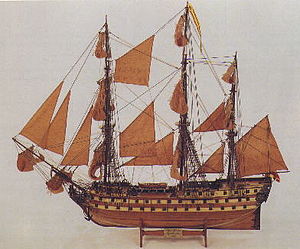- Spanish ship San Juan Nepomuceno
-

San Juan NepomucenoCareer 


Launched: Guarnizo (Cantabria), 1765 Fate: Captured, 22 October 1805 General characteristics Class and type: 74-gun third rate Displacement: 2,700 tons Complement: 530 Armament: 74 guns: 28 x 36 pdr, 30 x 18 pdr, 16 x 8 pdr San Juan Nepomuceno was a Spanish ship of the line launched in 1765 from the royal shipyard in Guarnizo (Cantabria). Like many 18th Century Spanish warships she was named after a saint (John of Nepomuk). She was a solidly built ship of proven seaworthy qualities.
Her sister-ships were San Pascual, San Francisco de Asis, San Lorenzo, Santo Domingo and San Agustín.
She was fitted with a total of 74 cannons: 28 24-pounders, 30 18-pounders, 8 12-pounders and 8 8-pounders, and was manned by 8 officers, 11 midshipmen, 19 leading seamen and 492 able seamen (530 total). Her supply capacity was for 60 days victuals and 80 days water.
She rendered numerous important services to the Armada (fleet), some of them in the Caribbean where she participated in several sieges and was distinguished in 1779.
In 1793, she took part in the Anglo-Spanish occupation of Toulon under the command of Admiral Don Juan de Lángara. Four years later, in 1797, she was part of a Spanish fleet under Teniente General José de Córdoba that fought against the British at the Battle of Cape St. Vincent.
The Battle of Trafalgar is the historical feat in which she participated and of which we have the best account. In spite of being dismasted by Admiral Nelson's artillery on the 21st October 1805, she achieved glory in this battle under the command of the famous Brigadier Don Cosme Damian Churruca and constituted for the Spaniards a handsome example of the heroism of their nation and the bravery of their sailors.
The San Juan Nepomuceno was one of the last ships still fighting after most of the French ships had surrendered and most of the Spanish ships had either been captured or had yielded. The commander, Don Cosme Churruca, had previously ordered for the flag to be nailed to the highest mast. At the time, it was commonplace for ships to signal surrender by lowering their nation's flag. 'Nailing the flag' was a way to tell the enemy, allies, and indeed the ship's own crew and officers not to expect an easy surrender. As the hours passed, the wounded Admiral Nelson continued to direct the battle, while the Brigadier Churruca, whose leg had been torn off by a cannon ball, the deck of his ship covered by the blood of his wounded and dead seamen, continued to stubbornly order his ship's batteries to fire. Mortally wounded, the Basque-born Churruca prohibited his officers from surrendering and ordered them to continue returning fire whilst he remained breathing. His officers kept their word, even after Churruca died and command of the ship had been passed to Francisco de Moyna (second-in-command), who continued the fight until he himself was killed, replaced by the next officer in command who also refused to surrender (he later fell under musket fire and was replaced by yet another officer). However, unable to break the circle of fire formed by the six enemy ships, which counted among others with the famous Defiance, Tonnant and Dreadnought, and in order to prevent the ship from sinking with all the wounded trapped below, the last officer left alive on the San Juan Nepomuceno yielded with over 400 dead and injured on board. The British obtained a brilliant victory but paid a high price in lives.
After Trafalgar, the ship was taken into British service as HMS San Juan and served as a supply hulk for many years at Gibraltar. In honour of Churruca's courage, the cabin he had occupied while alive bore his name on a brass plate, and all who entered it were required to remove their hats as a mark of respect for a gallant enemy.
Sources & references
John D. Harbron Trafalgar and the Spanish Navy (1988) ISBN 0-87021-695-3
External links
Historia del navío de línea San Juan Nepomuceno (in Spanish)
Categories:- Spanish Navy ships of the line
- 1760s ships
- Captured ships
- Napoleonic era ships
Wikimedia Foundation. 2010.


